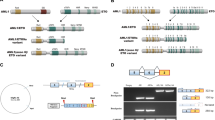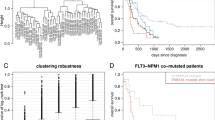Abstract
Acute myeloid leukemia (AML) with t(8;16)(p11;p13) (t(8;16) AML) has unique clinico-biological characteristics, but its microRNA pattern is unknown. We analyzed 670 microRNAs in seven patients with t(8;16) AML and 113 with other AML subtypes. Hierarchical cluster analysis showed that all t(8;16) AML patients grouped in an independent cluster. Supervised analysis revealed a distinctive signature of 94-microRNAs, most of which were downregulated, including miR-21 and cluster miR-17–92. The mRNA expression analysis of two known transcription factors of these microRNAs (STAT3 and c-Myc, respectively) showed significant downregulation of STAT3 (P=0.04). A bioinformatic analysis showed that 29 of the downregulated microRNAs might be regulated by methylation; we treated a t(8;16) AML sample with 5-aza-2′-deoxycytidine (5-AZA-dC) and trichostatin A and found that 27 microRNAs were re-expressed after treatment. However, there was no difference in methylation status between t(8;16) and other AML subtypes, either overall or in the microRNA promoter. Cross-correlation of mRNA and microRNA expression identified RET as a potential target of several microRNAs. A Renilla-luciferase assay and flow cytometry after transfection with pre-microRNAs confirmed that RET is regulated by miR-218, miR-128, miR-27b, miR-15a and miR-195. In conclusion, t(8;16) AML harbors a specific microRNA signature that is partially epigenetically regulated and targets RET proto-oncogene.
This is a preview of subscription content, access via your institution
Access options
Subscribe to this journal
Receive 12 print issues and online access
$259.00 per year
only $21.58 per issue
Buy this article
- Purchase on Springer Link
- Instant access to full article PDF
Prices may be subject to local taxes which are calculated during checkout



Similar content being viewed by others
References
Camos M, Esteve J, Jares P, Colomer D, Rozman M, Villamor N et al. Gene expression profiling of acute myeloid leukemia with translocation t(8;16)(p11;p13) and MYST3-CREBBP rearrangement reveals a distinctive signature with a specific pattern of HOX gene expression. Cancer Res 2006; 66: 6947–6954.
Haferlach T, Kohlmann A, Klein HU, Ruckert C, Dugas M, Williams PM et al. AML with translocation t(8;16)(p11;p13) demonstrates unique cytomorphological, cytogenetic, molecular and prognostic features. Leukemia 2009; 23: 934–943.
Borrow J, Stanton VP, Andresen JM, Becher R, Behm FG, Chaganti RS et al. The translocation t(8;16)(p11;p13) of acute myeloid leukaemia fuses a putative acetyltransferase to the CREB-binding protein. Nat Genet 1996; 14: 33–41.
Champagn N, Pelletier N, Yang XJ . The monocytic leukemia zinc finger protein MOZ is a histone acetyltransferase. Oncogene 2001; 20: 404–409.
Yang XJ, Ullah M . MOZ and MORF, two large MYSTic HATs in normal and cancer stem cells. Oncogene 2007; 26: 5408–5419.
Chan EM, Chan RJ, Comer EM, Goulet RJ, Crean CD, Brown ZD et al. MOZ and MOZ-CBP cooperate with NF-kappaB to activate transcription from NF-kappaB-dependent promoters. Exp Hematol 2007; 35: 1782–1792.
Vo N, Goodman RH . CREB-binding protein and p300 in transcriptional regulation. J Biol Chem 2001; 276: 13505–13508.
Blobel GA . CREB-binding protein and p300: molecular integrators of hematopoietic transcription. Blood 2000; 95: 745–755.
Wadgaonkar R, Phelps KM, Haque Z, Williams AJ, Silverman ES, Collins T . CREB-binding protein is a nuclear integrator of nuclear factor-kappaB and p53 signaling. J Biol Chem 1999; 274: 1879–1882.
Pasqualucci L, Dominguez-Sola D, Chiarenza A, Fabbri G, Grunn A, Trifonov V et al. Inactivating mutations of acetyltransferase genes in B-cell lymphoma. Nature 2011; 471: 189–195.
Mullighan CG, Zhang J, Kasper LH, Lerach S, Payne-Turner D, Phillips LA et al. CREBBP mutations in relapsed acute lymphoblastic leukaemia. Nature 2011; 471: 235–239.
Chen J, Odenike O, Rowley JD . Leukaemogenesis: more than mutant genes. Nat Rev Cancer 2010; 10: 23–36.
Santoro M, Melillo RM, Carlomagno F, Vecchio G, Fusco A . Minireview: RET: normal and abnormal functions. Endocrinology 2004; 145: 5448–5451.
Bartel DP . MicroRNAs: target recognition and regulatory functions. Cell 2009; 136: 215–233.
Vasudevan S, Tong Y, Steitz JA . Cell-cycle control of microRNA-mediated translation regulation. Cell Cycle 2008; 7: 1545–1549.
Bartel DP . MicroRNAs: genomics, biogenesis, mechanism, and function. Cell 2004; 116: 281–297.
Garzon R, Calin GA, Croce CM . MicroRNAs in Cancer. Annu Rev Med 2009; 60: 167–179.
Lu J, Getz G, Miska EA, Alvarez-Saavedra E, Lamb J, Peck D et al. MicroRNA expression profiles classify human cancers. Nature 2005; 435: 834–838.
Calin GA, Croce CM . MicroRNA signatures in human cancers. Nat Rev Cancer 2006; 6: 857–866.
Krol J, Loedige I, Filipowicz W . The widespread regulation of microRNA biogenesis, function and decay. Nat Rev Genet 2010; 11: 597–610.
Deng S, Calin GA, Croce CM, Coukos G, Zhang L . Mechanisms of microRNA deregulation in human cancer. Cell Cycle 2008; 7: 2643–2646.
Esteller M . Epigenetics in cancer. N Engl J Med 2008; 358: 1148–1159.
Garzon R, Croce CM . MicroRNAs in normal and malignant hematopoiesis. Curr Opin Hematol 2008; 15: 352–358.
Garzon R, Volinia S, Liu CG, Fernandez-Cymering C, Palumbo T, Pichiorri F et al. MicroRNA signatures associated with cytogenetics and prognosis in acute myeloid leukemia. Blood 2008; 111: 3183–3189.
Swerdlow SH, Campo E, Harris NL, Jaffe ES, Pileri SA, Stein H et al WHO Classification of Tumours of Haematopoietic and Lymphoid Tissues, IARC: Lyon, France, 2008.
Bennett JM, Catovsky D, Daniel MT, Flandrin G, Galton DA, Gralnick HR et al. Proposals for the classification of the acute leukaemias. French-American-British (FAB) co-operative group. Br J Haematol 1976; 33: 451–458.
Rozman M, Camos M, Colomer D, Villamor N, Esteve J, Costa D et al. Type I MOZ/CBP (MYST3/CREBBP) is the most common chimeric transcript in acute myeloid leukemia with t(8;16)(p11;p13) translocation. Genes Chromosomes Cancer 2004; 40: 140–145.
Fabbri M, Garzon R, Andreeff M, Kantarjian HM, Garcia-Manero G, Calin GA . MicroRNAs and noncoding RNAs in hematological malignancies: molecular, clinical and therapeutic implications. Leukemia 2008; 22: 1095–1105.
He L, Thomson JM, Hemann MT, Hernando-Monge E, Mu D, Goodson S et al. A microRNA polycistron as a potential human oncogene. Nature 2005; 435: 828–833.
Iliopoulos D, Jaeger SA, Hirsch HA, Bulyk ML, Struhl K . STAT3 activation of miR-21 and miR-181b-1 via PTEN and CYLD are part of the epigenetic switch linking inflammation to cancer. Mol Cell 2010; 39: 493–506.
Stark B, Resnitzky P, Jeison M, Luria D, Blau O, Avigad S et al. A distinct subtype of M4/M5 acute myeloblastic leukemia (AML) associated with t(8:16)(p11:p13), in a patient with the variant t(8:19)(p11:q13)--case report and review of the literature. Leuk Res 1995; 19: 367–379.
Chaffanet M, Gressin L, Preudhomme C, Soenen-Cornu V, Birnbaum D, Pebusque MJ . MOZ is fused to p300 in an acute monocytic leukemia with t(8;22). Genes Chromosomes Cancer 2000; 28: 138–144.
Panagopoulos I, Teixeira MR, Micci F, Hammerstrom J, Isaksson M, Johansson B et al. Acute myeloid leukemia with inv(8)(p11q13). Leuk Lymphoma 2000; 39: 651–656.
Panagopoulos I, Fioretos T, Isaksson M, Samuelsson U, Billstrom R, Strombeck B et al. Fusion of the MORF and CBP genes in acute myeloid leukemia with the t(10;16)(q22;p13). Hum Mol Genet 2001; 10: 395–404.
Glassman AB, Hayes KJ . Translocation (11;16)(q23;p13) acute myelogenous leukemia and myelodysplastic syndrome. Ann Clin Lab Sci 2003; 33: 285–288.
Rokudai S, Aikawa Y, Tagata Y, Tsuchida N, Taya Y, Kitabayashi I . Monocytic leukemia zinc finger (MOZ) interacts with p53 to induce p21 expression and cell-cycle arrest. J Biol Chem 2009; 284: 237–244.
Katsumoto T, Aikawa Y, Iwama A, Ueda S, Ichikawa H, Ochiya T et al. MOZ is essential for maintenance of hematopoietic stem cells. Genes Dev 2006; 20: 1321–1330.
Thomas T, Corcoran LM, Gugasyan R, Dixon MP, Brodnicki T, Nutt SL et al. Monocytic leukemia zinc finger protein is essential for the development of long-term reconstituting hematopoietic stem cells. Genes Dev 2006; 20: 1175–1186.
Goodman RH, Smolik S . CBP/p300 in cell growth, transformation, and development. Genes Dev 2000; 14: 1553–1577.
Kung AL, Rebel VI, Bronson RT, Ch’ng LE, Sieff CA, Livingston DM et al. Gene dose-dependent control of hematopoiesis and hematologic tumor suppression by CBP. Genes Dev 2000; 14: 272–277.
Rebel VI, Kung AL, Tanner EA, Yang H, Bronson RT, Livingston DM . Distinct roles for CREB-binding protein and p300 in hematopoietic stem cell self-renewal. Proc Natl Acad Sci USA 2002; 99: 14789–14794.
Hermeking H . p53 enters the microRNA world. Cancer Cell 2007; 12: 414–418.
Suzuki HI, Miyazono K . Dynamics of microRNA biogenesis: crosstalk between p53 network and microRNA processing pathway. J Mol Med 2010; 88: 1085–1094.
Prives C, Manley JL . Why is p53 acetylated? Cell 2001; 107: 815–818.
Figueroa ME, Lugthart S, Li Y, Erpelinck-Verschueren C, Deng X, Christos PJ et al. DNA methylation signatures identify biologically distinct subtypes in acute myeloid leukemia. Cancer Cell 2010; 17: 13–27.
Fazi F, Racanicchi S, Zardo G, Starnes LM, Mancini M, Travaglini L et al. Epigenetic silencing of the myelopoiesis regulator microRNA-223 by the AML1/ETO oncoprotein. Cancer Cell 2007; 12: 457–466.
Saumet A, Vetter G, Bouttier M, Portales-Casamar E, Wasserman WW, Maurin T et al. Transcriptional repression of microRNA genes by PML-RARA increases expression of key cancer proteins in acute promyelocytic leukemia. Blood 2009; 113: 412–421.
Takahashi M, Cooper GM . ret transforming gene encodes a fusion protein homologous to tyrosine kinases. Mol Cell Biol 1987; 7: 1378–1385.
Gattei V, Celetti A, Cerrato A, Degan M, De Iuliis A, Rossi FM et al. Expression of the RET receptor tyrosine kinase and GDNFR-alpha in normal and leukemic human hematopoietic cells and stromal cells of the bone marrow microenvironment. Blood 1997; 89: 2925–2937.
Acknowledgements
We thank Dr Francesco Lo Coco and Dr Tiziana Ottone (Hospital Tor Vergata, Rome), Dr David Grimwade and Dr Adam Ivey (Guy’s Hospital, London), and Dr Olga Salamero (Hospital Vall d’Hebron, Barcelona) for kindly providing us with three additional cases of AML associated to translocation t(8;16). This work was supported by grants from Fondo de Investigaciones Sanitarias/Instituto de Salud Carlos III PI080158, FIS-PI0900547 and N-2004-FS041085, and RETICS RD06/0020/0004. Marina Díaz-Beyá is supported by a ‘Premi Fi de Residència Emili Letang’ of the Hospital Clínic de Barcelona and Tania Díaz is an FI fellow supported by AGAUR, Generalitat de Catalunya and Fondo Social Europeo. Gerardo Ferrer is the recipient of a grant from ‘Instituto de Salud Carlos III’ (PFIS).
Author information
Authors and Affiliations
Corresponding author
Ethics declarations
Competing interests
The authors declare no conflict of interest.
Additional information
This research was presented in part at ASH 2010 meeting as an oral presentation.
Supplementary Information accompanies the paper on the Leukemia website
Supplementary information
Rights and permissions
About this article
Cite this article
Díaz-Beyá, M., Navarro, A., Ferrer, G. et al. Acute myeloid leukemia with translocation (8;16)(p11;p13) and MYST3-CREBBP rearrangement harbors a distinctive microRNA signature targeting RET proto-oncogene. Leukemia 27, 595–603 (2013). https://doi.org/10.1038/leu.2012.278
Received:
Revised:
Accepted:
Published:
Issue Date:
DOI: https://doi.org/10.1038/leu.2012.278
Keywords
This article is cited by
-
SLIT2 promoter hypermethylation-mediated SLIT2-IT1/miR-218 repression drives leukemogenesis and predicts adverse prognosis in myelodysplastic neoplasm
Leukemia (2022)
-
Two rare cases of acute myeloid leukemia with t(8;16)(p11.2;p13.3) and 1q duplication: case presentation and literature review
Molecular Cytogenetics (2020)
-
Targeting epigenetic regulators for cancer therapy: mechanisms and advances in clinical trials
Signal Transduction and Targeted Therapy (2019)
-
MicroRNA21 and the various types of myeloid leukemia
Cancer Gene Therapy (2018)
-
miR-203 and miR-221 regulate SOCS1 and SOCS3 in essential thrombocythemia
Blood Cancer Journal (2016)



